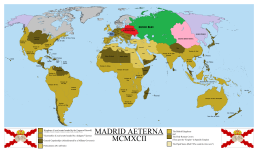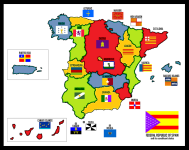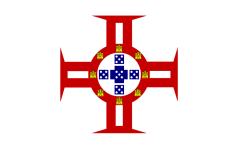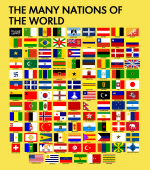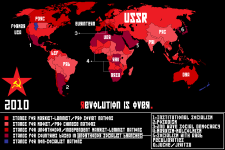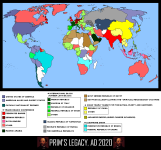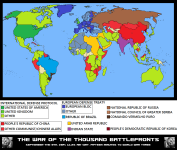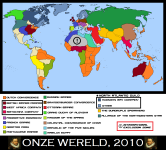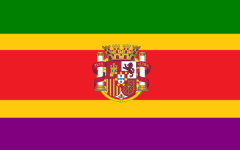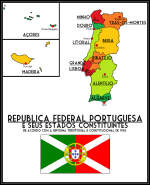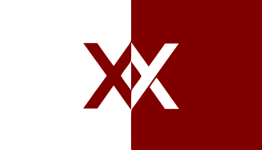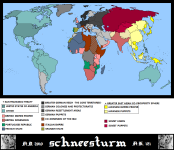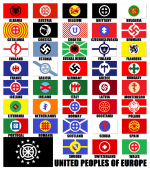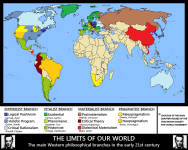Madrid Aeterna
Years ago, a friend of mine requested me a maximum HispanoWank. My pathological inability to give up an idea eventually turned that into this.
POD is in 1492, and TTL still has certain familiarities with OTL until late 16th century (that's why Madrid is still the capital of Spain. Charles V still existed and there was an alternate twin Philip II) -Ferdinand II's considerations had more weight than those of Isabella, so the the Jews and Moriscos were not expelled from Spain, having as the main positive side effects that the Salamanca School of Economics was more influent, civilizational identity was less religious-aligned, Peninsular economy was more equilibrated with its own social fabric, and a lesser religious scrutiny and a continuation of Erasmismo in the subsequent decades allowed a greater permeation of the ideas of modernity and for the formation of more philosophers and researchers and greater divulgation of OTL ones. The Company of Jesus, that still formed IOTL, stressed its humanistic tendencies respect to OTL. Blasco de Garay got funding, having much more maneuvrable warships. As a result, there were more key military victories in the 16th Century (the British Isles were puppetized and some chunks of land were gained from the Ottomans), and a better administered Hapsburg Empire never split its Spanish and its HRE parts. Holding much more key positions in the Old World, the Empire totally pwned in the alternate Religious Wars of the 17th century. France got the short end of the stick, and the king was beheaded after a military Republican revanchist movement caught up. France is, still to this day, an army with a country, and a very scary place. There was a massive Protestant emigration to Scandinavia, which suffered a theodemocratic Lutheran revolution, while the HRE was centralized to a degree and subordinated to the Hispanic Monarchy. The 18th century saw a scientific and industrial revolution, though technological progress was slower in development and extension due to a "if it ain't broke, don't fix it" mentality akin to that of the Roman Empire, and to nobility being more resilient to societal change. Spanish pattronage made Korea to pull a Meiji, and the Polish-Lithuanian Commonwealth to survive. During a series of wars in the late 19th century and the early 20th century, Spain reduced to rubble her main enemy, the Ottoman Empire. The world has seen a political equilibrium since then -Spain is hated by most of the remaining free nations, but not even all af them combined could defeat her, and they know.
Technologically, the Empire has a retro-futurist look that ranges from the early 20s to the late 60's (steam trains and elevated commuting systems, theaters that include cinema elements, electric and gas light; telephone, records and radio; airships and early airplanes, cars like those of the 1940's, color TV and early transistor computers in public and governmental buildings). Biotechnology is comparatively more advanced, and splicing and modification of the rásgulos (genes) is widely used, limits to it being heavily influenced by chatecist notions of dignity: greenhouse effect is well understood and, in spite of the state of industialization, is being tackled by massive empire-sponsored projects of forestation and soil-enriching and resistant crops.
The main entertainments of the Imperial population are the Patada (A version of the Calcio Fiorentino, like Football but with different rules, where both hands and feet are allowed and there is much more contact), the Pelota Court, the Cane Game (motorbike and horse combats where hollow canes are used instead of spears), and more recently, motor racing. Bullfighting, which developed different rites and rules, is becoming less popular as the concept of animal welfare arises, but it's still big in the Peninsular kingdoms, the American Viceroyalties and Nueva Extremadura. Peninsular culinary traditions have influenced the whole world -adopting local variations-, and in return, Peninsular cuisine is much more influenced by New Spanish/Mexican traditions, and Indian, Fasi/Moroccan, Catanite/Chinese and Legionarian/Sundanese cuisines are much appreciated within the Empire. Tapas are pervasive, here more often called botanas even in the Peninsula. The main world fast food is Gallinejas, originating in Madrid: deep-fried lamb and hen guts, often served with fries. Croqueta stalls and Azotabarbas joints -the latter being a sofrito, saffron and ham soup with very long noodles- are common too. There is a well developed Sefardi culinary tradition, with a predilection for poultry and aubergine as ingredients. Most middle and upper class men and women dress in strict black, in contrast to the Earth tones, the white and the flamboyant items of the lower classes. Vests, cloaks, combs and buns are still in fashion. Hats, when used, are very wide-brimmed. Women from all social classes tend to display embroided patterns in their dresses.
Politically, the Empire has become a semi-federalized structure based on a reform of the territorial and multicouncil structure existing since the Reyes Católicos. Apart from the Penisular Kingdoms depicted in the map, there are four sub-federal entities that are nominally part of a kingdom but retain their own fueros and institutions: the Principalities of Asturias and Catalonia, and the Lordships of Vizcaya and Molina. Male universal suffrage was developed in the mid 19th century, but female suffrage is a much more recent thing and not all structures are democratic, for the Empire evolved out of slow reform propelled by the incipent bourgeoisie, and there never was a revolution akin to the French one. The General Captainships, places deemed of strategic importance, are ruled by appointed members of the military (with an elected body of advisors that in practice do most of the administrative role, though), and the Emperor still has a direct influence in politics and an effective ability to veto decisions and appoint part of the legislative power, split between local courts (including the Holy Roman Imperial Diet) and the Empire-wide Consejo Imperial, which directly presides over several other empire-wide councils: War, Inquisition (a convenient tool to ensure the clergy's loyalty to the Emperor) Military Orders (a Nobility Forum, esentially), Imperial Researches (the Consejo de Pesquisas Imperiales is the Empire's intelligence agency), Industry (that is, Science and Technology, still with a notable Jesuitic presence), and Treasury. There should be a special mention to the Knights of Saint Ignacio. Originally a laymen's arm of assistance to the Jesuitic mission, and still heavily influenced by Ignatian principles, it is nowadays a corps de facto under the Council of Industry. With an alleged mission of helping bringing light to the Creation for the benefit of the Spains, in practice they work as part industrial spies, part treasure/artifact hunters.
The Pope still rules over the Papal States, but the Papacy submitted to the earthly Imperial authority and became the Emperor's personal rubber stamp centuries ago -it speaks volumes that Church confiscations were made by sucessive emperors ITTL and almost no one batted an eye about it. Still, in most parts of the Empire, the executive power falls over elected Adelantados. At a municipal level, the government is divided between the elected Alcaldes, who collect taxes and undertake public works and services, and appointed Corregidores, who act as judges of first instance, lead the Cuerpo de Alguaciles and maintain public order.
Catholicism is the official religion of the Empire, though worship freedom was never put into question, due to the numerous and influential religious minorities, and in its current form it has become a national church in all but name. Each court in the political frame has its set of factions, normally called Moderados (right-wing) and Libertinos (Liberal left-wing). A Neocomunero movement (a form of Republicanism with some Proto-Anarchist and Utopian Socialist elements) exists and has instigated many revolts and political killings in its extra-parliamentary forms, but no Socialist revolution has happened to date. The closest form of Fascism is a parliamentary minority faction, the Cordianos (the political wing of the Congregation of the Sacred Heart of Mary, a Traditionalist religious order of laymen, with some key industrialists on board, at odds with the Jesuitic influence in the Church) who want a Corporatist empire run by technocratic elements of the clergy, greater powers for the Inquisition (nowadays it has been reduced to a thought police that only has jurisdiction within the own clergy), and ultimately the elimination of Jews, Moors, Egiptanos -both Roma people and a colorful, psychedelic bohemian movement-, Troveros -a movement originating in Murcia and Granada, in which people satirize the powerful through improvised rhymes- and heathen Neocomunero elements. They appear to be funded by the Garduña, a global, xenophobic and esoteric Spanish crime syndicate. Between Jews there is a minority but influent Sionista movement, that wants the Kindom of Jerusalem to be reformed into an independent, Sefardi-dominated Jewish homeland. Independentism is a serious problem in Cipango, and a main source of terrorist attacks (it used to be a serious and bloody issue in Catai, but as the Viceroy and the bureaucracy are mostly Han there, the new generations are assuming a dual identity), and it's a source of revolts from time to time in the former Ottoman holdings, especially Anatolia. It's a much more culturally homogeneous world, with hundreds of extinguished languages and many on the verge of extinction, only spoken in rural areas -including English.
Goa, Ciudad de México and Cartagena de Indias, though less stunning -México comes close, though-, have a greater population than Madrid as cities proper. Madrid, with its 11 million inhabitants (it has swallowed Guadalajara and a Toledo that keeps a proud and useless independence), is something that one has to see before dying, or maybe a sight that can kill you. Between the mountains of San Lorenzo del Escorial, the Emperor Philip VIII beholds the monster from another monster, a High-Tech palace-monastery of Herrerian style that makes our El Escorial look like a dollhouse. A famous traveller notoriously said of his arrival to the Imperial capital:
"It looms suddenly, massive, stamped on the landscape. Its light wells up around the surrounds, the rock hills, like bruise-blood. I am debased. I am compelled to worship this extraordinary pressence that has stilted into existence at the conjuction of all roads. It is a vast pollutant, a stench, a klaxon sounding. It's not the road which pulls us, but the City itself, its weight sucks us in."
In the Iberian Peninsula, the heart of the Empire, the twelve most populated cities are as it follows:
1-Madrid (11,3 million inhabitants)
2-Sevilla (8,6 million inhabitants)
3-Valencia (7,5 million inhabitants)
4-Lisboa (5,2 million inhabitants)
5-Barcelona (4,7 million inhabitants)
6-Cádiz (2,3 Million inhabitants)
7-Bermeo (1,9 million inhabitants)
8-Murcia (1,7 million inhabitants)
9-Vigo (1,1 million inhabitants)
10-Salamanca (980.000 inhabitants)
11-Cartagena (950.000 inhabitants)
12-Valladolid (830.000 inhabitants)
A weird subculture, the Artificieros, has appeared: They dress in leather, listen to sampled industrial noises, use tinctured goggles and have very short hair, women included. They think of the Empire as an industrial-bureaucratic mechanical God that has taken consciousness and aspires to engulf the whole Universe, and they're trying to help It to achieve Its goals.
